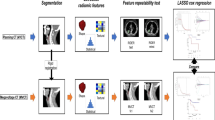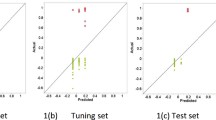Abstract
We investigated an approach for predicting recurrence after radiation therapy using local binary pattern (LBP)-based dosiomics in patients with head and neck squamous cell carcinoma (HNSCC). Recurrence/non-recurrence data were collected from 131 patients after intensity-modulated radiation therapy. The cases were divided into training (80%) and test (20%) datasets. A total of 327 dosiomics features, including cold spot volume, first-order features, and texture features, were extracted from the original dose distribution (ODD) and LBP on gross tumor volume, clinical target volume, and planning target volume. The CoxNet algorithm was employed in the training dataset for feature selection and dosiomics signature construction. Based on a dosiomics score (DS)-based Cox proportional hazard model, two recurrence prediction models (DSODD and DSLBP) were constructed using the ODD and LBP dosiomics features. These models were used to evaluate the overall adequacy of the recurrence prediction using the concordance index (CI), and the prediction performance was assessed based on the accuracy and area under the receiver operating characteristic curve (AUC). The CIs for the test dataset were 0.71 and 0.76 for DSODD and DSLBP, respectively. The accuracy and AUC for the test dataset were 0.71 and 0.76 for the DSODD model and 0.79 and 0.81 for the DSLBP model, respectively. LBP-based dosiomics models may be more accurate in predicting recurrence after radiation therapy in patients with HNSCC.




Similar content being viewed by others
References
Johnson DE, Burtness B, Leemans CR et al (2020) Head and neck squamous cell carcinoma. Nat Rev Dis Primers 6(1):92. https://doi.org/10.1038/s41572-020-00224-3
Terahara A, Niemierko A, Goitein M et al (1999) Analysis of the relationship between tumor dose inhomogeneity and local control in patients with skull base chordoma. Int J Radiat Oncol Biol Phys 45(2):351–358. https://doi.org/10.1016/s0360-3016(99)00146-7
Zukauskaite R, Hansen CR, Grau C et al (2018) Local recurrences after curative IMRT for HNSCC: effect of different GTV to high-dose CTV margins. Radiother Oncol 126(1):48–55. https://doi.org/10.1016/j.radonc.2017.11.024
Bortfeld T, Craft D, Dempsey JF et al (2008) Evaluating target cold spots by the use of tail EUDs. Int J Radiat Oncol Biol Phys 71(3):880–889. https://doi.org/10.1016/j.ijrobp.2008.01.049
Cheung FW, Law MY (2012) A novel conformity index for intensity modulated radiation therapy plan evaluation. Med Phys 39(9):5740–5756. https://doi.org/10.1118/1.4742848
Tomé WA, Fowler JF (2002) On cold spots in tumor subvolumes. Med Phys 29:1590–1598. https://doi.org/10.1118/1.4742848
Forastiere AA, Zhang Q, Weber RS et al (2013) Long-term results of RTOG 91 – 11: a comparison of three nonsurgical treatment strategies to preserve the larynx in patients with locally advanced larynx cancer. J Clin Oncol 31(7):845–852. https://doi.org/10.1200/JCO.2012.43.6097
Bernier J, Domenge C, Ozsahin M et al (2004) Postoperative irradiation with or without concomitant chemotherapy for locally advanced head and neck cancer. N Engl J Med 350(19):1945–1952. https://doi.org/10.1056/NEJMoa032641
Cooper JS, Zhang Q, Pajak TF et al (2012) Long-term follow-up of the RTOG 9501/intergroup phase III trial: postoperative concurrent radiation therapy and chemotherapy in high-risk squamous cell carcinoma of the head and neck. Int J Radiat Oncol Biol Phys 84(5):1198–1205. https://doi.org/10.1016/j.ijrobp.2012.05.008
Denis F, Garaud P, Bardet E et al (2004) Final results of the 94-01 French Head and Neck Oncology and Radiotherapy Group randomized trial comparing radiotherapy alone with concomitant radiochemotherapy in advanced-stage oropharynx carcinoma. J Clin Oncol 22(1):69–76. https://doi.org/10.1200/JCO.2004.08.021
Brockstein B, Haraf DJ, Rademaker AW et al (2004) Patterns of failure, prognostic factors and survival in locoregionally advanced head and neck cancer treated with concomitant chemoradiotherapy: a 9-year, 337- patient, multi-institutional experience. Ann Oncol 15(8):1179–1186. https://doi.org/10.1093/annonc/mdh308
Begg AC (2012) Predicting recurrence after radiotherapy in head and neck cancer. Semin Radiat Oncol 22(2):108–118. https://doi.org/10.1016/j.semradonc.2011.12.002
Kamezawa H, Arimura H, Yasumatsu R et al (2020) Preoperative and non-invasive approach for radiomic biomarker-based prediction of malignancy grades in patients with parotid gland cancer in magnetic resonance images. Med Imaging Inf Sci 37(4):66–74. https://doi.org/10.11318/mii.37.66
Le QC, Arimura H, Ninomiya K et al (2020) Radiomic features based on hessian index for prediction of prognosis in head-and-neck cancer patients. Sci Rep 10(1):21301. https://doi.org/10.1038/s41598-020-78338-7
Wu A, Li Y, Qi M et al (2020) Dosiomics improves prediction of locoregional recurrence for intensity modulated radiotherapy treated head and neck cancer cases. Oral Oncol 104:104625. https://doi.org/10.1016/j.oraloncology.2020.104625
Ojala T, Pietikainen M (2002) Multiresolution gray-scale and rotation invariant texture classification with local binary patterns. IEEE Trans Pattern Anal Mach Intell 24(7):971–987. https://doi.org/10.1109/TPAMI.2002.1017623
Perrin T, Midya A, Yamashita R et al (2018) Short-term reproducibility of radiomic features in liver parenchyma and liver malignancies on contrast-enhanced CT imaging. Abdom Radiol (NY) 43(12):3271–3278. https://doi.org/10.1007/s00261-018-1600-6
Sicilia R, Cordelli E, Merone M et al (2019) Early radiomic experiences in classifying prostate cancer aggressiveness using 3D local binary patterns. IEEE 32nd International Symposium on Computer-Based Medical Systems (CBMS), 2019:355–360. https://doi.org/10.1109/CBMS.2019.00078
D’ Amico NC, Sicilia R, Cordelli E et al (2020) Radiomics-based prediction of overall survival in lung cancer using different volumes-of-interest. Appl Sci 10:6425. https://doi.org/10.3390/app10186425
Grossberg A, Elhalawani H, Mohamed A et al (2020) M.D. Anderson Cancer Center Head and Neck quantitative imaging Working Group. HNSCC [Dataset]. The Cancer Imaging Archive
Chawla NV, Bowyer KW, Hall LO et al (2002) SMOTE: synthetic minority over-sampling technique. J Artif Intell Res 16:321–357. https://doi.org/10.1613/jair.953
Vallières M (2018) Radiomics: MATLAB programming tools for radiomics analysis. GitHub; 2015. https://github.com/mvallieres/radiomics. Accessed 30 Nov 2018
Haralick RM, Shanmugam K, Dinstein I (1973) Textural features for image classification. IEEE Trans Syst Man Cybern SMC–3(6):610–621. https://doi.org/10.1109/TSMC.1973.4309314
Galloway MM (1975) Texture classification using gray level run length. Comput Graph Image Process 4:172–179. https://doi.org/10.1016/S0146-664X(75)80008-6
Thibault G, Fertil B, Navarro C et al (2009) Texture indexes and gray level size zone matrix. Application to cell nuclei classification. Proc of Pattern Recognition and Information Processing, pp 140–145
Amadasun M, King R (1989) Textural features corresponding to textural properties. IEEE Trans Syst Man Cybern 19:1264–1274. https://doi.org/10.1109/21.44046
Gillison ML, Trotti AM, Harris J et al (2019) Radiotherapy plus cetuximab or cisplatin in human papillomavirus-positive oropharyngeal cancer (NRG Oncology RTOG 1016): a randomised, multicentre, non-inferiority trial. Lancet 393(10166):40–50. https://doi.org/10.1016/S0140-6736(18)32779-X
Oyeyemi GM, Ogunjobi EO, Folorunsho AI (2015) On performance of shrinkage methods—a Monte Carlo study. Int J Stat Appl 5(2):72–76
Bogowicz M, Tanadini-Lang S, Guckenberger M et al (2019) Combined CT radiomics of primary tumor and metastatic lymph nodes improves prediction of loco-regional control in head and neck cancer. Sci Rep 9(1):15198. https://doi.org/10.1038/s41598-019-51599-7
Tang FH, Chu CYW, Cheung EYW (2021) Radiomics AI prediction for head and neck squamous cell carcinoma (HNSCC) prognosis and recurrence with target volume approach. BJR Open 3:20200073. https://doi.org/10.1259/bjro.20200073
Diamant A, Chatterjee A, Vallières M et al (2019) Deep learning in head & neck cancer outcome prediction. Sci Rep 9(1):2764. https://doi.org/10.1038/s41598-019-39206-1
Bufacchi A, Caspiani O, Rambaldi G et al (2020) Clinical implication in the use of the AAA algorithm versus the AXB in nasopharyngeal carcinomas by comparison of TCP and NTCP values. Radiat Oncol 15(1):150. https://doi.org/10.1186/s13014-020-01591-7
Haga A, Takahashi W, Aoki S et al (2018) Classification of early stage non-small cell lung cancers on computed tomographic images into histological types using radiomic features: interobserver delineation variability analysis. Radiol Phys Technol 11(1):27–35. https://doi.org/10.1007/s12194-017-0433-2
Forde E, Leech M, Robert C et al (2021) Influence of inter-observer delineation variability on radiomic features of the parotid gland. Phys Med 82:240–248. https://doi.org/10.1016/j.ejmp.2021.01.084
Arimura H, Soufi M, Ninomiya K et al (2018) Potentials of radiomics for cancer diagnosis and treatment in comparison with computer-aided diagnosis. Radiol Phys Technol 11(4):365–374
Acknowledgements
We would like to thank Editage (www.editage.com) for English language editing.
Funding
This work was supported by JSPS KAKENHI Grant Number JP22K15808 and Teikyo University Research Grant Number 2100007.
Author information
Authors and Affiliations
Contributions
All the authors contributed to the conception and design of the study. The material preparation, data collection, and analysis were performed by HK. The first draft of the manuscript was written by HK, and all the authors commented on the previous versions of the manuscript. All authors have read and approved the final manuscript.
Corresponding author
Ethics declarations
Conflict of interest
The authors declare that they have no conflict of interest.
Ethical approval
This article does not include any studies with human participants or animals performed by any of the authors.
Additional information
Publisher’s Note
Springer Nature remains neutral with regard to jurisdictional claims in published maps and institutional affiliations.
Rights and permissions
Springer Nature or its licensor (e.g. a society or other partner) holds exclusive rights to this article under a publishing agreement with the author(s) or other rightsholder(s); author self-archiving of the accepted manuscript version of this article is solely governed by the terms of such publishing agreement and applicable law.
About this article
Cite this article
Kamezawa, H., Arimura, H. Recurrence prediction with local binary pattern-based dosiomics in patients with head and neck squamous cell carcinoma. Phys Eng Sci Med 46, 99–107 (2023). https://doi.org/10.1007/s13246-022-01201-8
Received:
Accepted:
Published:
Issue Date:
DOI: https://doi.org/10.1007/s13246-022-01201-8




